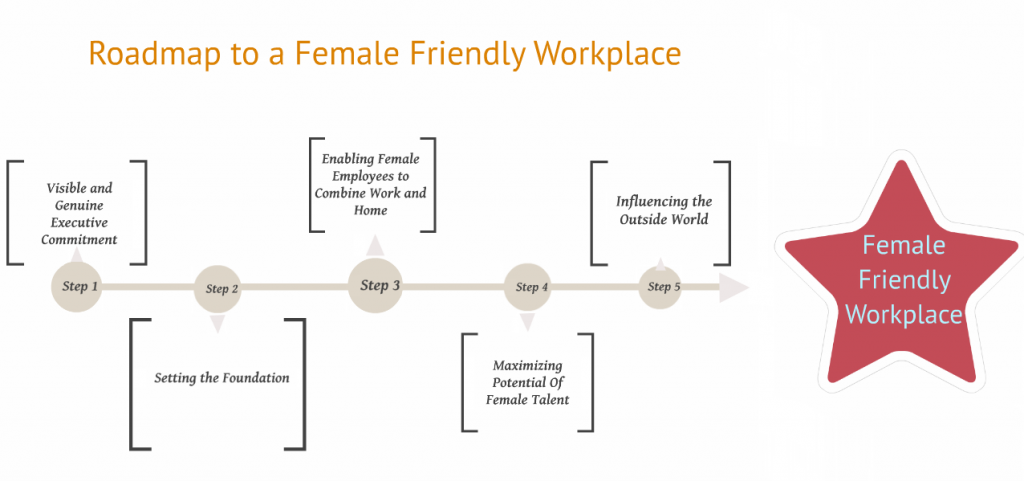I don’t have to talk about the advantages of creating a gender diverse workplace anymore. I’ve done that in many previous articles and blogs, such as Companies Who Got Gender Diversity Right and Businesswomen on Top – Views on Gender Diversity. And of course our first ever research report on Women@Work in Pakistan also highlighted the benefits in a roadmap on how to create a female friendly workplace.
Over the last couple of years a number of leading companies in Pakistan have shown commitment and drive which has accelerated the progress of creating more female friendly workplace. I wanted to share some of their examples hoping that they’ll inspire other companies to do the same while recognizing these leading companies for the great work they are doing.
Step 1: Visible and Genuine Executive Commitment
The first step is for the organization’s leadership team to be convinced that having a gender-balanced organization is smart business. It’s not about being politically correct or morally doing the right thing. It simply gives better returns. The executive team has to be able to focus on the long-term benefits and not be swayed by the ‘naysayers’ who focus on short term issues such as maternity leaves and other gender related performance biases. The stronger the position they take on this, the more successful their gender diversity initiative will be.
Nestle Pakistan kicked off their gender diversity drive with senior leadership team sessions facilitated by there global head of gender diversity, Sue Johnson to create shared understanding, build commitment and agree a plan on how to become a more female friendly workplace.
Step 2: Set the Foundation
As soon as the executive team has made a public and genuine commitment to enhance the participation of women in their organization, the company has to set its foundations. This includes:
- Creating policies on matters such as equal opportunities, reward and sexual harassment to solidify their commitment
- Adjusting HR processes on hiring, development, promotions and succession planning to ensure at a minimum that gender bias is reduced and possibly that women candidates are at least included in people decisions
- Creating a safe and female friendly work place by providing facilities that ensure the safety of female staff at all times and enables them to perform to their ability
- Helping male colleagues and specifically male line managers to become aware of specific gender related barriers and how to create a supportive and female friendly work place
Telenor Pakistan recently invited Engage Women to conduct gender diversity awareness sessions for their line managers. In these sessions we specifically focused on creating awareness about our gender biases and the impact they have on the way we operate and develop an inclusive workplace.
Step 3: Enable Female Employees to Combine Work and Home
Pakistani society has not progressed to a point where it’s acceptable for a woman not to be a home maker. As a result she’s always dealing with the pressure that comes with managing both home and work. For companies in Pakistan to be successful in their gender diversity initiatives it’s important for them to extend their support to do this. It shouldn’t become the reason women leave the workplace after getting married or having children.
Companies should do as much as possible to create flexible work arrangements and allow, if required, employees to work from home to fulfill personal commitments. This flexibility should not only be offered to women but to all employees alike so that a distinction isn’t created between genders in the organisation.
Almost all leading companies in Pakistan have now created an environment in which female employees are provided with specific support to help them combine work and home such as transport arrangements, access to sponsored nurseries, flexibility in maternity leave and flexitime. An often observed difficulty in these practices is that they specifically benefit the female workforce creating animosity under the male members of the organisation. As part of a global imitative Unilever Pakistan has resolved this by enabling their workforce, both women and men, to work one day a week from home.
Step 4: Maximizing Potential
With the foundations and enablers in place it’s time to focus on providing high performing women with specific support and opportunities. This can be done in the form of:
- Assigning executive mentors and coaches
- Nominating women for specific training and development opportunities
- Creating networking occasions (with other women) in the company
- Women talent review sessions in which the senior leadership team reviews and agrees development interventions for high performing female talent
BAT Pakistan recently launched numerous initiatives to help and support woman navigate their career in BAT through mentor sessions, networking events and buddy systems.
Step 5: Influencing the Outside World
The final step is to come out in the open by using the traction and success you’ve generated inside the company to influence other companies and society. This can be done through:
- Sponsoring of gender diversity initiatives and events
- Holding specific female candidate outreach and sponsoring programs
- Taking ownership of specific female friendly initiatives such as supporting women to came back to work after a long maternity break
- Launching part-time work or job-sharing initiatives
Telenor Pakistan recently launched an initiative in which they offer woman to resume their career after a long maternity leave workplace experience to build up confidence (both at home, at work and with the individual) and ease them back into their careers.
Pepsi Pakistan probably has the most successful and widely recognized female friendly workplace in Pakistan. They’ve implemented all the above steps and are reaping the benefits with the highest representation of woman in their leadership. They’re able to attract, develop and retain top female talent for their organisation in Pakistan and are also providing top notch talent for their global operation.
If you like these steps, subscribe to the blog to get more tips directly to your inbox. If you implement any of them, share your experiences in the comments below.





Good Article. At Marie Stopes Society – Pakistan, we give five days “Work from Home” and “Time off in lieu” against working on weekends to our female staff who continuously do field visits. This benefit is very well received and we are able to retain our female staff. thanks